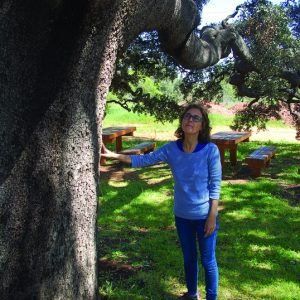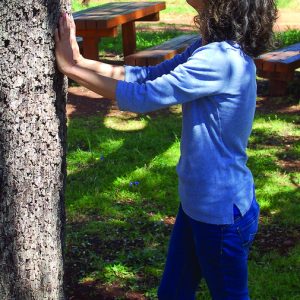ECO123 talked to Cassandra Jorge Querido (aged 54), a landscape architect who was born in Évora and has been working for the past 26 years on matters relating to the environment. We met in the picnic area, at Benafim, in the municipality of Loulé, beneath an oak-tree, a holm-oak tree that is over 500 years old. We talked and had lunch together…
Is the new Law No. 10/2018 going to help prevent fires in Portugal?
In my opinion, this law isn’t in any way fit for purpose. And it may even make matters worse if it’s implemented.
So, it’s dangerous?
Yes, it’s dangerous. In my view, this law was made with eucalyptuses in mind, so that we can fight against them, creating spaces and establishing a whole scenario whereby we can combat fires more easily: keeping gaps between trees, cutting back shrubs and bushes and making everything easier so that we can fight the fires. And then we have to apply it to the eucalyptus grove. Eucalyptus trees should be treated like wild animals.
Like what?
Like wild animals. When we bring lions to Portugal, there’s no ecological niche, no special habitat for them to live in… It doesn’t make sense to leave an elephant in the Alentejo. It might find a way to subsist, but it will probably destroy a lot of things.
It’s the same thing with the eucalyptus. It came from Australia, where there are animals that eat it: koala bears. It’s a form of natural control, and there also some insects that can cause harm to the tree. Over there, there are ways of controlling it, but not here. There are already some diseases here in Portugal that can harm the tree, but it’s like a wild animal. And it should be treated as such. A eucalyptus grove must be planted in a confined area. It only makes sense if a eucalyptus grove is planted with a gap between it and the indigenous species.
The only improvement that’s been made with this law is the insistence on a distance between the species, but only when it’s applied to the eucalyptus and the pine-tree. If we go around cutting down trees and leaving a four-metre gap between them, we’ll be creating the perfect conditions for the appearance of thick, sun-loving scrubland. Often, it’s the shade from the tree tops that helps to control the spread of this vegetation.
And there’s no sunlight.
Because there’s no sunlight.
And without light, nothing grows.
Exactly. What happens when we cut down trees indiscriminately is that scrubs start to grow, because they like the heat and the sunlight. They like fires.
Or, in other words, in the parliament and at the ministries, they’re equating the eucalyptus with the cork-oak, or with any other type of tree.
Exactly. What are the exceptions? They may exist in protected areas, and they can be made by the municipal committees set up to defend the forest against fires. But, what you find most frequently, for example on Estrada Nacional No. 2 (which is a road I like a lot), is unclassified places where you can see lots of cork trees.
And even some 500-year-old trees? Will they have to be chopped down?
Yes.
What a danger for Portugal!
Yes. In the Alentejo, for example, there are lots of cork trees.
By law, cork trees can’t be chopped down.

They’re protected by law. But let’s imagine, for example, that we want to comply with Law No. 10/2018, about forest fires. We may have to ask the ICNF (Institute for Nature Conservation and Forests) to cut down trees. Let’s imagine a place with lots of old trees. We may have to cut them down because their tops cannot be kept at the required distance of four metres.
And then, there may be cases where the trees aren’t very old, but they have a very imposing aspect. This decree has another exception, relating to trees planted in line, such as plane trees. These are planted by the roadside, and they have a special legal status, as they fulfil a particular landscape function. Often, as in the Alentejo, the plane trees end where a grove of cork trees or holm oaks begins. Now, to protect those trees, under the exception permitted by this law, there has to be a gap of more than ten metres between the tree tops. And only after that can there be other species. If we’re in an area where there are plane trees in the middle of a cork oak grove, then either we cut down the plane trees or we cut down the whole grove.
And so it doesn’t make any sense to cut down the grove. Because, very often, if we’re cutting down the grove, we’re cutting down the landowner’s own trees.
Maintaining means maintenance.
But maintenance doesn’t mean cutting down; instead, it means preserving.
If we are to fully comply with the law, then we can’t preserve some trees. Plane trees are tall. But they’re not a fire hazard, because they’re not pyrophytes. Even if we cut down every other plane tree, in order to leave a four-metre gap, it won’t be because of this that the fire slows down.
And it will let in sunlight.
Yes, it’ll let in sunlight. So, these are things that don’t make any sense.
There are various realities that the law has to adapt to: there’s country life and there’s city life. Farmers, countryfolk, know how to look after a forest. It needs to be cleaned, but in a selective way. Do you think that everyone in the country should keep at least fifty thousand litres of rainwater stored in their tanks? And a tree is a kind of fuel, isn’t it?
It is, yes. We’re talking about “fuel” management, in this case. It’s as if we were talking about oil.
Exactly. If we look more closely at this way of formulating a law, we’ll find the true spirit behind it. It’s the spirit of a government in Lisbon, which probably doesn’t even have the slightest idea what’s happening, for example, in Viseu, Castelo Branco, Coimbra, the Algarve, the Alentejo, the Minho– in places where we have cork and holm-oak groves,
for example, or indigenous forests.
There’s also the point that the South has a number of differences compared to the North. In the South, we have more people dealing with things locally, on the spot. And the forest has benefited a great deal from the fact that cork trees and holm oaks are protected by law. It has meant that we haven’t been so quick in moving to the widespread planting of eucalyptus.
In the North, not only has there been a widespread planting of eucalyptus trees, and consequently of more fire-prone and less indigenous forests, but people have also moved away more from the countryside. As far as the management of the vegetation is concerned, we engage in regular cleaning operations and we know what we’re supposed to clean. Actually, in reality, we control the vegetation rather than clean it, because there’s nothing here that’s dirty. There’s no dirt here; this is vegetation, for heaven’s sake.
In the old days, for example, people knew that rock rose bushes could be cut down and used as firewood, given their readily combustible properties. And that meant that the woods were kept clean, but nobody undertakes that kind of forest management anymore.
What’s the problem of the North compared to the South?
There’s fewer people in the countryside and more people in the cities, and they have a lot more emigrants in the countryside, who are away working in France.
And so they’ve abandoned the countryside.
Yes. And there are also older people who live right next door to eucalyptus groves, because these generate some income for them.
When I studied Agronomy, I remember being told that eucalyptus groves were planted for the marriages of daughters. Fifteen or twenty years later. The olive trees were for their children and the cork trees were for their grandchildren. So, in the North, the forest was transformed in a way that wasn’t ideal.
Nowadays, the forest is just regarded as a source of income. If it doesn’t provide an immediate profit, then it’s no longer worth the trouble.
Yes.
So, we need to look for solutions earlier. Instead of talking about income, we have to be thinking about other values…
Where things have improved a little in the North – in comparison with the South, for example – has been in relation to the uncultivated areas that belong to no one, but which are instead common ground belonging to the community. In those areas, they can decide to plant indigenous trees, but also eucalyptuses, although this isn’t very common.
Furthermore, it’s very often the smallholders who create the problem. When it’s just a small-scale farmer planting eucalyptus trees, it’s far worse than Portucel. Portucel makes a great investment, which means that they have enough money to make all the fire belts just as they should be with the right number of metres of clear space.
Today, we have another factor to take into account: CO2. The rising temperatures also make fires worse, with strong winds pulling the fire from one side of the country to the other, over dozens of kilometres…
The eucalyptus tree has its own propagation strategy. The leaves fall and are blown around like helicopters, helping to spread the fire. This also happens with the rock rose. And it’s the same thing with the pine tree. When there are fires, the pine-tree drops its pine-cones much further away. The eucalyptus only makes matters worse because it has a shorter fire cycle; a pine-tree has a twenty-year fire cycle.
What will be the next step in ensuring that there are fewer fires?
A good start would be to begin with fuel breaks, in those containment areas next to the road, giving them a different treatment. People have to understand that trees have to be treated in accordance with the place that you’re passing through. Or, in other words, if there’s an area of eucalyptus, there’s a special modus operandi, and this has to vary according to the type of space in question. It’s not a recipe, like the one that was provided by the Decree-Law that came before this 2018 law.
You can have certain guidelines, but these have to be adapted to different contexts. Above all, you’ve got to create more buffer zones, areas planted with indigenous trees that are resistant to fires. And this is important because, in fact, in our forests, even in the Alentejo, there are more monocultures of cork oaks. These are more resistant to fires, but they’re still monocultures.
Fuel breaks are designed to prevent fires starting next to a road, for example. And they prevent a cigarette end thrown carelessly by the roadside from setting fire to the first nearby rock rose bush.
You have to understand that, in certain areas, the vegetation has to be different. But you won’t change things just by making decrees.
It’s obvious that we need more people on the land.
We need greatly improved conditions for people living in the country and working the land. The eucalyptuses have to be confined to certain areas. If we want them in order to produce and export paper, then they have to be in a place where they don’t cause anybody any harm. Then we’ve got to have methods of prescribed burning. Prescribed burning is a good solution in the case of eucalyptus and pine groves, in places where there are fire-prone species, and the aim is to get rid of the whole land cover. But prescribed burning isn’t a good solution in areas of indigenous plantations, because we’ll be giving greater strength to the fire-prone plants. The rock rose can release its seeds, even at low temperatures, because prescribed burning is a low temperature fire. And this really is clearing vegetation. Because it dries everything, it makes the land much drier. The organic material, the forest floor, is dry. When the leaves fall from the trees, they form a cover or blanket that enables the rain to seep into the ground more easily, and when this is destroyed, or reduced, with the heat, the soil becomes less porous. So, there’s less infiltration of rainwater. If prescribed burning is performed on a slope or a hillside, then the ashes from the fire can make their way down into the streams and watercourses. The ashes are, in themselves, nutrients. Everything that grows will die one day and will be returned back into the earth again.
And what about the queimadas (the fires that local farmers light to clear their land and control pests and weeds)?
These queimadas can sometimes be the start of forest fires if they’re not controlled properly.
Many fires begin with queimadas.
People gather together all their waste and, instead of grinding it up and returning it to the earth, they burn it. Many of the nutrients evaporate. This is the case with the sulphates, and a part of the phosphorus.
Law No. 10/2018 isn’t very educational. We can convince people with education – but not with threats.
A law that immediately begins by talking about fines and penalties isn’t going to create good bonds.
The problem that came with all this legislation after the forest fires was that the politicians were all scared.
Instead of supporting farmers, they threaten them with fines.
They were so scared that they did something that people would have to submit to rapidly. If you don’t clean your land, you immediately get fined. For some years, they acted in a more educational fashion, going to places, talking to people, through the civil protection services. But what people are lacking is knowledge. The civil protection services have got hold of a law that doesn’t even understand vegetation very well, using just the part about the “cleaning” of the forests so that they can probably fight fires better. They decided to make a law that regards trees, shrubs and herbaceous plants all in the same way. They only differentiated the eucalyptuses and the pine-trees, with the rule about the ten-metre distance between them and other species, and that’s it.
This law should have been passed many years ago. Whoever made it should sit down at the table and discuss these matters, and not just with those who spend their time fighting fires. They should also be talking to agents specialising in vegetation, who know which plants burn more easily, which ones are more fire-resistant – they should find out how vegetation behaves. And then they’d be in the right position to establish guidelines.
Even when they talk about the undergrowth in cork-oak groves, they treat the forests as if they were all the same. And that’s why in certain places, such as the Serra do Caldeirão, you can find cork trees dying. They have lots of diseases, especially in those areas where people have cut down most of the vegetation. Biodiversity is very important. It’s what makes the trees healthy. This is the way the cycle of nutrients operates.
There’s no future in single crops. They have an incomplete cycle of nutrients. They can’t develop and they can’t synthesise properly. They’re short of nutrients, and they can’t get hold of everything they need. Trees need mushrooms and micro-roots. In the old days, there was no mechanisation, there was no screening, and you didn’t cut back the roots of the cork-oaks and holm-oaks. There were symbioses, with mycorrhizae, which also help to create more nutrients. Today, the micro-roots are cut away, the branches are used for firewood, the whole of the undergrowth is removed… the tree is exposed to violent sunshine in the summer, the roots die due to a dreadful lack of water because it’s impossible to keep the soil moist.
To understand the life of trees, we need to develop an understanding about Nature. Do you have any confidence in the public services in Portugal?
Ah! I don’t know what I’m supposed to make of that. I try to do my bit. Once I was told the story of the humming bird and the drop of water. The bird takes a drop of water in its beak and releases it over the fire. And someone says: “Oh, humming bird, you have to be more sensible! You’re so small and with your little drop of water, you’re not doing anything to help.” “But I’m doing my bit,” says the bird. And it’s more or less like this, I’m like the humming bird. I’m doing my bit. Probably, I’m not doing very much, but I am doing my bit.
Do you have any dreams?
From a practical point of view, that’s what I do, dealing with the vegetation by the roadside. The cycle of nutrients is very important. It’s the basis of all this. The vegetation is the producer and we have to respect it and give it back to the soil so that it can continue to produce. If we were always wasting it, which is what we’re doing today… In the old days, we used to waste it too, but things found their way back into the cycle, somewhere else. Today, the other place is a long way away, far from everything. It’s the sea. It’s all going to be drained away to the bottom of the oceans.
The solution is to make the most of everything that is excrement, manure, reintegrate it into the system and not throw it all into the sea, just as they’re doing now, for example, in Vienna or Beijing.
Do you have any other dream on your list?
We can transform ourselves, and that’s a dream. I do it often. I myself change things, I’m a bit of a sower. That tree that exists in Alferce, the quercus canariensis, is an oak-tree from Monchique. I sometimes go there and pick up acorns and plant them in other places. I took a course so that I could collect certified seeds of forest species, and I think it’s important that we have our own personal vision to contribute to that sowing. This is also important.
Reconstructing the biodiversity of a forest is also a part of it, trying to fight against invasive species. Note that the eucalyptus is already classified as an invasive plant. But mimosas and acacias have also contributed to making the forest more fire-prone than it used to be. So, the Mediterranean forest has always been fire-prone, ever since the Neolithic age. It would be useful if people tried to fight against acacias in an effective way and if there were more studies that focused on this aspect. We have to have some sensitivity and some knowledge. If not, the only thing we know how to do is to put glyphosate on everything. We have to know how to look after things properly.
Trees make a kind of contract with us – a symbiosis. Why is their fruit so appetising? Because the plants know that if we eat it, we will give food to their seeds. It’s a contract that we entered into with them many millions of years ago. And so did all the other animals. When we swallow the seed, we are going to fertilise something. Giving this back to the sea is breaking a contract that we made with the plants. Even when we eat plants that have a pip or a stone, what they’re asking us to do is to take the seed and throw it far away, asking us to sow another tree. They’re counting on us to do this. There are seeds that stick to the fur of animals, there are some that pass through our digestive systems, and there are others that have wings (these are already self-sufficient and don’t need animals to help them). There’s a kind of contract: you fertilise us and we’ll return the favour by feeding you.
To understand the life of trees, flora and fauna, we need to love Nature. We’re talking about a circular process, aren’t we?
Yes, and we’re the ones who are breaking it.
Thank you.
 Eco123 Revista da Economia e Ecologia
Eco123 Revista da Economia e Ecologia


